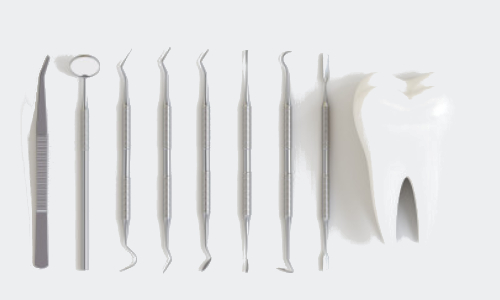
IMPLANTS

An Implant is an artificial or an inert material that is placed to replicate the roots of the natural tooth to support a crown or fixed or removable teeth in the form of dentures.
WHERE WE CAN USE IMPLANTS.
- In patients, who have lost all their teeth, where due to advanced bone loss, it is difficult to chew food due to inadequate retention of a denture.
- When only few missing teeth are present, but the removable partial denture may weaken the supporting teeth and provide less chewing efficiency.
- For single tooth replacements, where fixed partial dentures or bridges cannot be placed.
- Patient's desire.
BENEFITS OF USING IMPLANTS.
- Preservation of bone-The implant holds the bone like a natural tooth thereby preventing the progress of bone loss around it.
- Improved function -The chewing efficiency is almost 90% of the natural teeth.
- Aesthetics-Implants provide a natural appearance of the tooth, as it acts as the tooth root over which the tooth structure is placed.
- Stability and retention-Implants are more stable and retentive due to direct attachment of implant to the bone called as osseointegration.
- Comfort-Implants are more comfortable to the patient as compared to any case of denture replacements.
LIMITATIONS OF IMPLANTS.
- Implants cannot be used in medically compromised patients who cannot undergo surgery.
- It may require multiple visits to the dentist after implant placement and patient cooperation is must.
- It cannot be universally placed due to anatomical limitations means in situations where there is inadequate bone remaining.
PARTS OF AN IMPLANT
Techniques Of Implant Placement
Guided Surgery- Flapless
Flap Surgery
Guided Surgery - Flapless for Implants
It is a minimally invasive procedure which uses custom fabricated surgical guides or 3D softwares of the jaw bones where the dental implant is placed through the mucosal tissues without reflecting a flap
It is done in cases where the bone level is found satisfactory
It produces less post-operative swelling and discomfort to the patient as it is minimally invasive and involves no reflection of flap
It also causes less bone loss as compared to flap reflective procedures and better results in esthetic regions where implants are to be placed
a) Pre-operative site, c) Xray of the missing tooth, e) punch cut into the mucosa, g) drilling the hole into the bone for implant placement, h) implant screw to be placed, i) placing of the implant, k) after implant placement intro operative photo, i) abutment placed
Implant placement by flapless surgery
Flap Surgery for Implants
It involves various flap designs placed in order to permit better visualization of the bone and reduces the risk of bone perforation
It is usually done in cases of less bone levels that may need bone grafting to increase the bone level
It is an invasive procedure and may lead to swelling and post operative discomfort
Listen to our patient what they have to say about treatment after their fully recover.